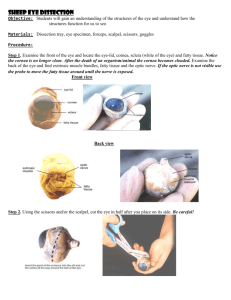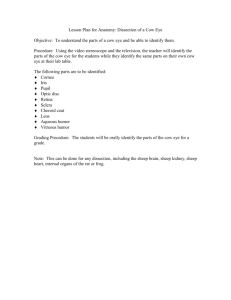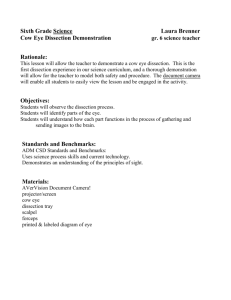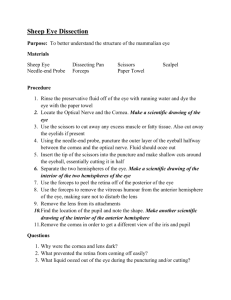Cow Eye Dissection
advertisement
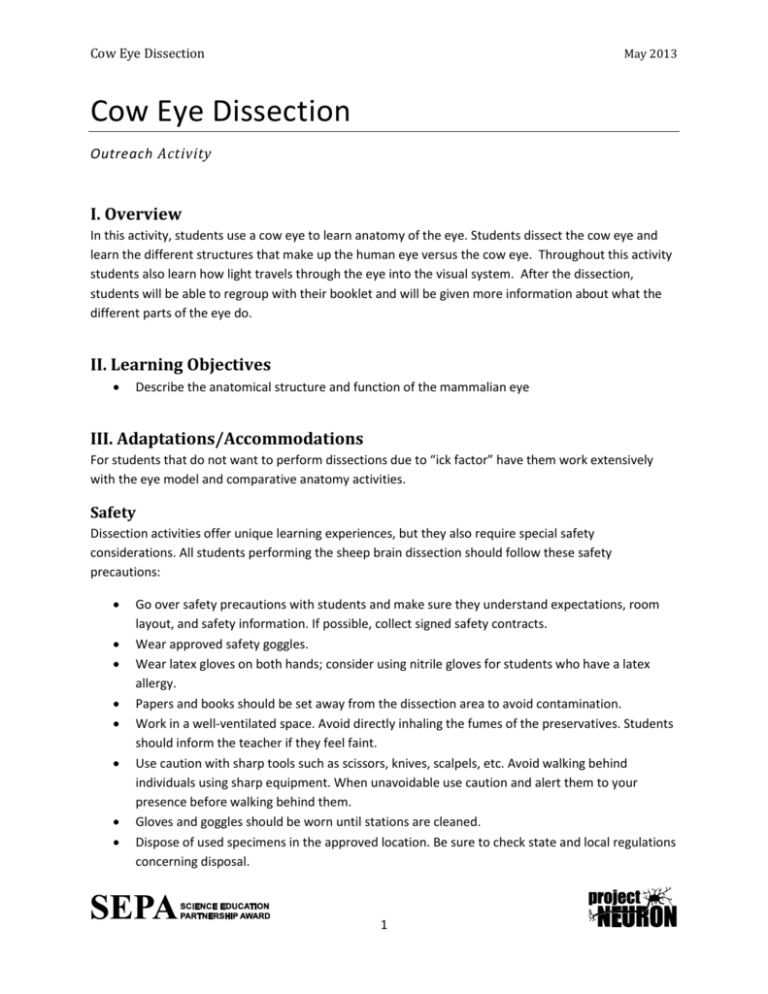
Cow Eye Dissection May 2013 Cow Eye Dissection Outreach Activity I. Overview In this activity, students use a cow eye to learn anatomy of the eye. Students dissect the cow eye and learn the different structures that make up the human eye versus the cow eye. Throughout this activity students also learn how light travels through the eye into the visual system. After the dissection, students will be able to regroup with their booklet and will be given more information about what the different parts of the eye do. II. Learning Objectives Describe the anatomical structure and function of the mammalian eye III. Adaptations/Accommodations For students that do not want to perform dissections due to “ick factor” have them work extensively with the eye model and comparative anatomy activities. Safety Dissection activities offer unique learning experiences, but they also require special safety considerations. All students performing the sheep brain dissection should follow these safety precautions: Go over safety precautions with students and make sure they understand expectations, room layout, and safety information. If possible, collect signed safety contracts. Wear approved safety goggles. Wear latex gloves on both hands; consider using nitrile gloves for students who have a latex allergy. Papers and books should be set away from the dissection area to avoid contamination. Work in a well-ventilated space. Avoid directly inhaling the fumes of the preservatives. Students should inform the teacher if they feel faint. Use caution with sharp tools such as scissors, knives, scalpels, etc. Avoid walking behind individuals using sharp equipment. When unavoidable use caution and alert them to your presence before walking behind them. Gloves and goggles should be worn until stations are cleaned. Dispose of used specimens in the approved location. Be sure to check state and local regulations concerning disposal. 1 Cow Eye Dissection May 2013 Dissection equipment should be washed, and work spaces should be wiped down with paper towels and a spray cleaner. Once cleaned spaces are approved by the facilitator, students should dispose of gloves, clean and replace their goggles, and immediately wash their hands at the nearest sink. IV. Timeframe for activity All the activities described here should take about 1 hour V. Advance prep and materials Materials: cow eyes probes scissors gloves goggles plates/trays eye dissection guides eye models (2) plastic table cloths wet wipes paper towels disinfectant spray Preparation: Drape table cloths over each of the tables on which students will be doing the dissections Set up 15 stations each with the following materials: probe, scissors, and dissection guide. Have the goggles and gloves ready for students to pick up before beginning dissections. Have the 15 trays of one eye on each ready at the front of the station to distribute once instructions have been given and students have their gloves and goggles on. Have wet wipes ready for students (or facilitators) to wipe down goggles after each set of students. Have paper towels and disinfectant spray ready for clean up during or after the activity. VI. Resources and references Facilitator resources Associated NEURON Lesson Plan: http://neuron.illinois.edu/lesson/lesson-1-what-do-you-see Eye Construction Game: http://neuron.illinois.edu/games/eye-construction-game VII. Activity Implementation Opening of Activity: Tell the students they will be dissecting cow eyes in this activity. Some students may be uncomfortable with this. If they are, try to encourage them to sit with a friend who wants to dissect and they can just actively observe without touching anything. Even still some students may object to participating in the 2 Cow Eye Dissection May 2013 activity. If this is the case, have them move on to the eye model and Comparative Neuroanatomy activities. Before allowing students to begin the dissection activity, provide them with clear instructions and expectations. Review with them the safety instructions indicated in the “Safety” section above and make sure all students understand proper protocol. If students misbehave or refuse to follow safe protocol, they will be asked to no longer participate in the activity. Before the students sit down at their respective dissection stations, be sure that they are wearing latex gloves and safety goggles. If there are students sitting down without proper protection, insist that they follow the safety precautions before continuing, and warn them that refusal to do so will result in them being unable to participate in the dissection. Inform the students that there are cow eye dissection guides on the dissection tables and they should follow the directions in the guide so they can appropriately identify structures on the exterior and interior of the eye. Activity 1: Examination of the exterior of the eye Start by having the students examine the exterior of the eye. See how many parts of the eye they can identify. From the outside of the eye they should be able to see: o The sclera (the whites of the eye), which is a tough outer covering of connective tissue that protects the outer most layer of the eye ball. The sclera covers everything but the cornea. Ask the students why they think the sclera doesn’t cover the cornea? o The cornea is where the light enters the eye so covering this structure with protective connective tissue would blind the animal. o The fat and muscle around the eye. Tell the students that the muscles they see are the ones that moved the eye around in the living cow. o The cornea, which is the covering on the front of the eye. The cornea is the only transparent (the cornea may be cloudy, because the cow is no longer alive) part of the eye’s exterior. It allows for light to enter the lens The cornea accounts for 2/3rd of the eye’s optical power The cornea is a very important organ in the eye because it allows for light to enter the rest of the eye. Looking through the cornea they can see The iris (the colored part of the eye). The iris is a circular structure that is a muscle that can change its shape to control the amount of light entering the eye. o The iris controls the size of the pupil 3 Cow Eye Dissection May 2013 The pupil (the dark oval in the middle of the iris), lets light pass through it into the eye. o The size of the pupil is controlled by the iris. o The bigger the pupil, the more light can enter the eye o Ask the students: how big are you pupils after you turn off the lights? What happens to your pupils when you turn the lights on? The pupil size increases when it is darker and is decreases when it is brighter. After examining the exterior of the eye have the students cut away the fat and muscle (step 2 in dissection guide). Activity 2: Investigate the inside of the eye. Be sure the students are referring to the dissection guides on their table for directions on where to cut on the eye. Have the students use scissors to make a cut in the cornea (the clear covering on the front of the eye) (step 3 in dissection guide). o Have the students cut until the clear liquid under the cornea is released. The liquid under the cornea is called the aqueous humor. This liquid is constantly replenished in the live animal. Because the cornea is transparent for light to enter the eye, no blood vessels can be there to feed it nutrients. Thus, the aqueous humor provides nutrients to the cornea. o Have the students cut through the sclera in the middle of the eye (step 4 in dissection guide). o Using scissors have the students continue cutting around the middle of the eye to separate the eye into 2 halves (step 5 in guide). The front half will have the cornea Place this half on the cutting surface and cut the cornea with your scissors. o The students will likely hear a crunch when they cut the cornea because the cow’s cornea has many layers to make it think and strong. The layers of the cornea provide a barrier from substances in the outside world entering it. One of the layers is dedicated to preventing the cornea from swelling forward. One of the layers is dedicated to perfusing liquid through the cornea so that it has enough but not too much fluid. 4 Cow Eye Dissection May 2013 Activity 3: Explore the inside of the front half of the eye Have the students explore the inside of the front half of the eye. In step 6 of the guide they are told to pull out the iris, which is the brown muscle between the cornea and the lens. o Tell the students in some eyes the iris might be stuck in the back of the eye, but it should come out in one piece. o The hole in the center of the iris is the pupil, it lets light into the eye. Ask the students how the iris changes its shape due to changes in light availability? The iris will contract its muscles to make the pupil smaller or larger depending on how much light is available. o At night the iris will make the pupil larger, when its bright out the iris will make the pupil smaller. Activity 4: Explore the inside of the back half of the eye The back of the eye is filled with clear jelly. This is called the vitreous humor, which is a mixture of protein and water. o The vitreous humor is a gel like substance that helps maintain the round shape of the eye. Without the vitreous humor the eyeball would look collapsed, it makes up 80% of the eye to hold its spherical shape The students will then remove the lens (step 7 in guide). The lens is a clear lump that is about the size and shape of a squashed marble. o The lens is a transparent sphere that can change its shape to focus the light entering the eye. o The lens of the cow’s eye feels soft on the outside and hard in the middle. Ask the students what they see when they hold up the lens and look through it They see an image of themselves upside down. o Because the lens is thicker in the middle than on the edges the way light refracts in the lens when it is held at a distance it makes images appear upside down. So our retina actually sees images as upside down and our brain learns within a matter of days how to perceive these upside down images, right side up. Ask the students what they see when they put the lens down on a newspaper? The students see that the words on the paper are much larger under the lens. o Tell the students that when the distance of an object is extremely close to the lens, then it can be used as a magnifier. A magnifying glass uses biological design of the lens to see magnify things that are close. 5 Cow Eye Dissection May 2013 After doing the experiments with the lens have the students look at the back of the eye again. o If the vitreous humor is still in the eyeball empty it out. o Inside the back of the eyeball students can see some blood vessels that are part of a thin fleshy film. This film is the retina. The retina is made up of cells (photo receptors) that can detect light and send messages to the brain. This layer of the eye converts light into nerve impulses. Photoreceptors contain light absorbing chemicals called photopigments that convert, or transduce, light energy into neural energy when they absorb light. This neural information is sent out to the brain through the optic nerve. The retina is attached to the back of the eye at one spot (blind spot). This spot is the optic nerve. The optic nerve is where all of the cells of the retina come together to form the optic nerve. The optic nerve carries messaged form the eye to the brain; it is the primary connection between the eye and the brain. o The spot where the retina attaches to the back of the eye is called the blind spot. There are no light-sensitive cells at that spot. o The optic nerve looks like a white stump sticking out of the outside half of the back of the eye (step 13 in guide) Under the retina the back of the eye is covered with shiny blue-green stuff. This is the tapetum. It reflects light from the back of the eye into the retina. This structure is not found in the human eye. o The tapetum increases the amount of light in the retina, it is found in many nocturnal animals so they can see better at night. When light shines into the eyes of animals that have tapetums (cats, dogs, etc.) light shines through their pupils, causing “eyeshine” and makes their eyes appear to be glowing. EYE MODELS: Two eye models are available for use in this station. These models can be used in two ways. While the students are working through the eye dissection, the facilitators can walk around with the eye models showing students on the models what they are looking at on the real eye specimens. Students can also use the eye models themselves after they have finished the dissections, removed their gloves, and washed their hands. ****CLEAN UP----once finished with the dissection many students will want to keep examining the eyes. Other students will be eager to move on to the next activity. Before moving on have students clean up their dissection station and remove and properly put away their safety goggles and throw away their gloves before washing their hands. It is imperative that students wash their hands after dissection and before moving on to new stations or activities. **** If there is time, ask students to answer questions in their booklet that are relevant to the eye dissection they just did. 6


